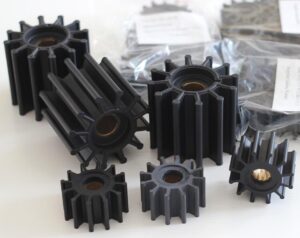When it comes to choosing the right rubber for applications in sea water, it's essential to consider factors such as corrosion resistance, flexibility, and durability. Certain types of rubber are better suited to handle the harsh conditions of marine environments, where exposure to saltwater and other environmental elements can cause deterioration over time.
For applications in sea water, rubber materials like EPDM, Viton, and Neoprene are often the best options due to their resistance to water and salt.

"Sea water rubber impellers for pumps"
Let’s explore the different rubber options available for sea water applications and the reasons behind their effectiveness in such harsh conditions.
What is the best rubber for marine environments?
For marine applications, rubbers like EPDM (Ethylene Propylene Diene Monomer) and Viton are often chosen for their excellent resistance to water and salt. What is EPDM rubber?1
EPDM and Viton are commonly used in marine environments for their resistance to saltwater, ensuring the longevity and durability of seals and gaskets.
EPDM rubber is widely used for its resistance to water, steam, and salt. It’s particularly effective in sealing applications for boats, ships, and offshore platforms. EPDM does not degrade when exposed to saltwater, making it ideal for sealing gaskets and O-rings in marine applications. On the other hand, Viton, a fluoroelastomer, offers excellent resistance to sea water, oils, and chemicals, making it a premium choice for critical sealing components in the marine industry. It also performs well at high temperatures and in extreme environmental conditions.
EPDM vs Viton: Marine Applications
| Material | Saltwater Resistance | Temperature Resistance | Flexibility |
|---|---|---|---|
| EPDM | Excellent | -50°C to +150°C | High |
| Viton | Excellent | -20°C to +200°C | Moderate |
Is Neoprene a good choice for sea water applications?
Neoprene rubber also performs reasonably well in sea water applications, though it is not as durable as EPDM or Viton. What is Neoprene rubber?2
Neoprene offers moderate resistance to sea water but may not withstand long-term exposure as well as EPDM or Viton.
Neoprene is a synthetic rubber with good resistance to oil, water, and chemicals, making it a versatile choice for a variety of applications. While it can resist the corrosive effects of saltwater for short periods, its performance deteriorates over extended exposure. Neoprene is often used for applications like boat hull seals, wet suit gaskets, and marine hoses. However, for long-term exposure to harsh marine conditions, materials like EPDM or Viton are typically better suited for providing durable, long-lasting seals.
Neoprene in Marine Environments
| Material | Saltwater Resistance | Temperature Resistance | Chemical Resistance |
|---|---|---|---|
| Neoprene | Moderate | -40°C to +120°C | Moderate |
What about Fluoroelastomers in sea water?
Fluoroelastomers, such as Viton, are ideal for high-performance seals in sea water. What are fluoroelastomers?3
Fluoroelastomers, like Viton4, are the most reliable for high-performance sealing in sea water due to their superior chemical and temperature resistance.
Fluoroelastomers are among the most durable materials for sealing in extreme environments, including sea water. They are resistant to both saltwater and a wide range of chemicals, making them a top choice for applications that require long-lasting and robust seals in marine environments. Viton, in particular, offers excellent sealing properties even in the harshest conditions, making it a go-to material for seals and gaskets used in offshore drilling, marine engines, and chemical plants exposed to seawater. While more expensive than EPDM or Neoprene, fluoroelastomers provide unparalleled durability and resistance, particularly in critical applications.
Fluoroelastomers for Marine Use
| Material | Saltwater Resistance | Temperature Resistance | Chemical Resistance |
|---|---|---|---|
| Fluoroelastomer | Excellent | -20°C to +200°C | Excellent |
Conclusion
For marine applications where sea water exposure is a factor, EPDM, Viton, and fluoroelastomers are often the best rubber choices. While Neoprene is suitable for short-term use, materials like EPDM and Viton offer better long-term durability and saltwater resistance5.
Footnotes
EPDM is widely used in marine applications for its excellent resistance to saltwater, steam, and UV rays, making it an ideal material for boat gaskets and O-rings. ↩
Neoprene provides moderate resistance to sea water but tends to degrade faster than EPDM or Viton in harsh marine environments. ↩
Fluoroelastomers like Viton are the most durable material for sea water applications, offering high resistance to saltwater, chemicals, and high temperatures. ↩
Explore how Viton enhances sealing performance in marine environments, ensuring durability and reliability in harsh conditions. ↩
Understand the importance of saltwater resistance in material selection for marine applications to ensure longevity and performance. ↩







